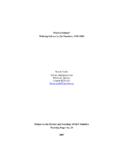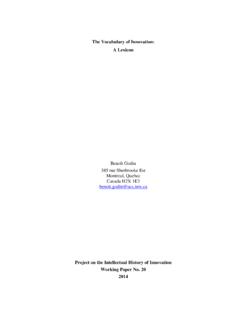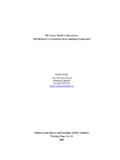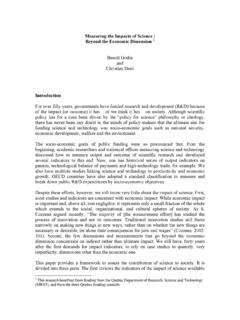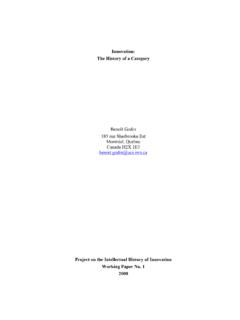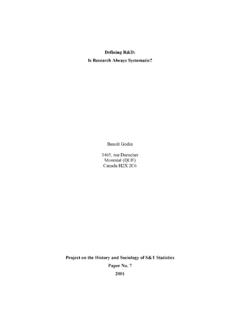Transcription of The Most Cherished Indicator: Gross Domestic Expenditures ...
1 The Most Cherished Indicator: Gross Domestic Expenditures on R&D (GERD). Beno t Godin 3465 Durocher Street Montreal, Quebec Canada H2X 2C6. Project on the History and Sociology of S&T Statistics Working Paper No. 22. 2003. Previous Papers in the Series: 1. B. Godin, Outlines for a History of Science Measurement. 2. B. Godin, The Measure of Science and the Construction of a Statistical Territory: The Case of the National Capital Region (NCR) . 3. B. Godin, Measuring Science: Is There Basic Research Without Statistics? 4. B. Godin, Neglected Scientific Activities: The (Non) Measurement of Related Scientific Activities. 5. H. Stead, The Development of S&T Statistics in Canada: An Informal Account.
2 6. B. Godin, The Disappearance of Statistics on Basic Research in Canada: A Note. 7. B. Godin, Defining R&D: Is Research Always Systematic? 8. B. Godin, The Emergence of Science and Technology Indicators: Why Did Governments Supplement Statistics With Indicators? 9. B. Godin, The Number Makers: A Short History of Official Science and Technology Statistics. 10. B. Godin, Metadata: How Footnotes Make for Doubtful Numbers. 11. B. Godin, Innovation and Tradition: The Historical Contingency of R&D Statistical Classifications. 12. B. Godin, Taking Demand Seriously: OECD and the Role of Users in Science and Technology Statistics. 13. B. Godin, What's So Difficult About International Statistics?
3 UNESCO and the Measurement of Scientific and Technological Activities. 14. B. Godin, Measuring Output: When Economics Drives Science and Technology Measurements. 15. B. Godin, Highly Qualified Personnel: Should We Really Believe in Shortages? 16. B. Godin, The Rise of Innovation Surveys: Measuring a Fuzzy Concept. 17. K. Smith, Measurement of Innovation in Europe: Concepts, Experience and Results. 18 B. Godin, A Note on the Survey as Instrument for Measuring S&T. 19 B. Godin, Rhetorical Numbers: How the OECD Constructs Discourses on Science and Technology. 20. B. Godin, Are Statistics Really Useful? Myths and Politics of Science and Technology Indicators. 21. B. Godin, The New Economy: The Diminishing Returns of Statistics.
4 Canadian Science and Innovation Indicators Consortium (CSIIC). 3465 Durocher Street, Montreal, Quebec H2X 2C6. Telephone: (514) 499-4074 Facsimile: (514) 499-4065. 2. The Most Cherished Indicator: Gross Domestic Expenditure on R&D (GERD). The OECD Frascati manual, now in its sixth edition, is the international standard for 1. conducting national surveys on R&D. It essentially develops two measurements of investment (or inputs) into science and technology: the financial resources invested in R&D, and the human resources devoted to these activities. To properly conduct surveys of R&D, the manual suggests precise definitions of R&D and which activities fall under this heading, as well as those that should be excluded.
5 Each of the two measures can be analyzed in terms of three dimensions. The first is the type or character of the research, which is either basic, applied or concer ned with the development of products and processes. This is a fundamental classification scheme in science and technology measurement. 2 The second dimension is the sectors that finance or execute the research: government, university, industry or non-profit organizations. It is these institutions that are the object of measurement, and not the individuals of which 3. they are composed. Finally, in relation to this latter dimension, monetary and human resources are (ideally) classified by discipline in the case of universities (and non-profit organizations), by industrial sector or product in the case of firms, and by function or 4.
6 Socioeconomic objective in the case of governments. The main indicator to come out of the Frascati manual is Gross Domestic Expenditure on R&D (GERD) the sum of R&D Expenditures in the following four economic sectors: 1. OECD (2003), The Measurement of Scientific and Technical Activities: Proposed Standard Practice for Surveys of Research and Development, Paris. 2. B. Godin (2003), Measuring Science: Is There Basic Research Without Statistics?, Social Science Information, in press. 3. B. Godin (2002), Metadata: How Footnotes Make for Doubtful Numbers, Project on the History and Sociology of S&T Statistics, Montreal. 4. B. Godin (2002), Innovation and Tradition: The Historical Contingency of R&D Statistical Classification, Project on the History and Sociology of S&T Statistics, Montreal.
7 3. 5. business, university, government and non-profit. According to a recent survey by the OECD Secretariat, GERD is actually the most Cherished indicator among OECD member 6 7. countries, despite the frequent suggestion that human resources are a better statistic, 8. and despite unanimous demand for output indicators. This paper explains where the indicator comes from. The first part presents early efforts to measure R&D on a national scale in order to determine a country's science or research budget. The second discusses how the NSF improved upon previous experiments, to the point where the OECD conventionalized the agency's choices and methodologies. The third part discusses the uses of the indicator, and the role the OECD played in its popularization.
8 The First Exercises on a National Budget Statistics on R&D started to be collected in the early 1920s in the United States, then 9. Canada and Great Britain. The US National Research Council was a pioneer with its repertories of industrial laboratories. Several surveys and statistical analyses used the data coming out of these publications. Then, in the 1940s, government began surveying its own research activities. Before the 1950s, measurement of R&D was usually conducted on individual sectors. Organizations surveyed either industrial or government R&D, for example, but very rarely aggregated the numbers to compute a national research budget (see Appendix). The first such efforts arose in Great Britain and the United States, and were aimed at assessing the share of Expenditures that should be devoted to science (and basic science).
9 5. The measure includes R&D funded from abroad but excludes payments made abroad. 6. OECD (1998), How to Improve the MSTI: First Suggestions From Users, DSTI/EAS/STP/NESTI/RD. (98) 9. 7. B. Godin (2002), Highly Qualified Personnel: Should We Really Believe in Shortages, Project on the History and Sociology of S&T Statistics, Montreal. 8. B. Godin (2002), Measuring Output: When Economics Drives Science and Technology Measurements, Project on the History and Sociology of S&T Statistics, Montreal. 9. B. Godin (2002), The Number Makers: Fifty Years of Science and Technology Official Statistics, Minerva, 40 (4), pp. 375-397. 4. compared to other economic activities, and at helping build a case for increased R&D.
10 Resources. J. D. Bernal was one of the first academics to perform measurement of science in a Western country. He was also one of the first to figure out how much was spent nationally on R&D the budget of science, as he called it. In The Social Function of Science (1939), Bernal estimated the money devoted to science in the United Kingdom using existing sources of data: government budgets, industrial data (from the Association 10. of Scientific Workers) and University Grants Committee reports. He had a hard time compiling the budget, however, because the sources of money used for science do not correspond closely to the separate categories of administration of scientific research.
